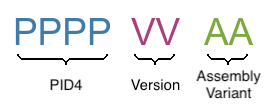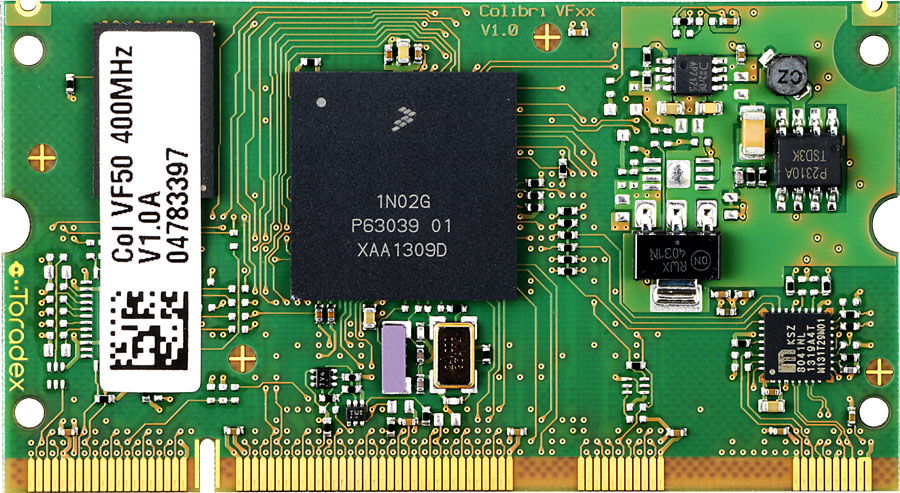Colibri VF50
Getting Started
Colibri VF50 is a member of the Colibri family. You will find all technical details such as features, datasheets, software, etc. here.
Recommendation for a first-time order
For starting for the first time with your Colibri VF50 you will need a suitable Colibri Carrier Board as well as some adapters and cables for connecting your desired interfaces.
Toradex recommends to order the following accessories for your fist-time order:
- Colibri Evaluation Board: For an easy evaluation of Colibri interfaces.
- Carrier Board Accessory Kit: Including suitable cables, adapters and a power supply.
You can buy the Colibri VF50 module, Colibri Evaluation Board and Carrier Board Accessory Kit from the Toradex webshop.
Getting started for the first time?
For detailed step-by-step instructions about how to start using Embedded Linux, please have a look at our step-by-step Getting-Started Guide:
Additional information
For information on how to update the module's Operating System, or change from Embedded Linux to Windows CE and vice-versa, please check the article below:
We also have quick video tutorials on our Youtube Channel:
For developing software on the platform, please browse through the list of knowledge-base articles provided in the link below:
Having trouble?
Please contact our technical support. Various option of technical support are mentioned in the article below.
Features
Processor
- NXP/Freescale Vybrid VF5xx - Cortex™-A5 (400MHz)
- L1 Instruction cache = 32KB (A5)
- L1 Data cache = 32KB (A5)
- Floating Point VFPv4
- NEON Support
Memory
- 128MB DDR3 RAM (16 Bit)
- 128MB NAND Flash (8 Bit)
Interfaces
- USB 2.0(1x Host, 1x OTG)
- I2C (4x)
- SPI (4x + 2x QSPI)
- UART (5x)
- IrDA (1x)
- PWM (18x)
- GPIOs (up to 103)
- Analog Input (16x 12 Bit)
- Ethernet (1x 10/100 Mbit IEEE1588)
- Ethernet RMII (1x)
- SDIO/SD/MMC (2x 4 Bit)
- CAN (2x)
- RGB (1024x768x24bpp)
- Resistive Touch (4-wire)
- Camera Parallel Interface (1x)
Supported operating systems
Datasheets
Module's Datasheet
Additional Resources
Software
Get details including free downloads of images and BSPs for operating systems supported by Colibri VF50.
In-house development and support
3D Models
Toradex provides two different 3D models for Colibri Systems on Module:
- Generic Colibri 3D Mechanical Models: This model has the maximum component height for testing the mechanical fit. This ensures the mechanical design fits all current Colibri modules as well as future releases.
- Specific Colibri 3D Mechanical Models: These models are simplified models of the respective Colibri module. They contain only the PCB and the CPU and are intended to be used for heat spreader or heat sink designs. The CPU height is a typical value. Due to production tolerances, the actual height of the assembled component can be different.
Generic Colibri 3D Mechanical Models
The generic Colibri 3D model contains the PCB and the maximum component height on top and bottom of modules from the Colibri Module Family. This model should be used to test the mechanical fit, ensuring that the mechanical design fits all current Colibri modules as well as future releases.
- SolidWorks CAD model 3D EASM model
- You can download the free eDrawings model viewer from SolidWorks here
- 3D STEP model that can be opened and modified in any 3D CAD
- 3D PDF model that can be opened in Adobe Reader
Colibri VFxx - Specific 3D Mechanical Models
The Colibri VFxx 3D model is simplified and contains only the PCB and the CPU. It is intended to be used for heat spreader or heat sink designs. The CPU height is a typical value. Due to production tolerances, the actual height of the assembled component can be different. Please use the Generic Colibri 3D Mechanical Models with the maximum component height for testing the mechanical fit. This ensures the mechanical design fits all current Colibri modules as well as future releases.
- SolidWorks CAD model 3D EPRT model
- You can download the free eDrawings model viewer from SolidWorks here
- 3D STEP models that can be opened and modified in any 3D CAD. The simplified model does not contain any copper pads.
- 3D PDF model that can be opened in Adobe Reader
Carrier Boards
Off-the-shelf Carrier Boards
From Toradex
From Partners
Custom Carrier Board Design
Find free reference designs, schematics, 3D designs and tools to build your carrier board easily in the link below.
Accessories
- Display EDT
- Colibri Fasteners
- Capacitive Touch Display 7" Parallel
- Resistive Touch Display 7" Parallel
- Carrier Board Accessory Kit
- LM816 USB WiFi
- Analogue Camera Adapter
Revision History
Click to See the Product Numbering Scheme
Product Number (PID8) Format
The format of the 8-digits Product Number (PID8) is the following:

The below table describes the structure of the Product Number (PID8):
| Field | Description |
|---|---|
| PPPP | 4-digits number, indicating the Product Configuration (PID4) that describes the key properties of the product (e.g. Product Group, RAM capacity, etc.) |
| VV | 2-digits number, indicating the Major and Minor Version (in that order) |
| AA | 2-digits number, indicating the Assembly Variant |
See the complete list of available combinations on the Revision History table of the corresponding product page.
Example
Product number (PID8): 00291100:
0029: Apalis iMX6D 512MB11: Major Version 1, Minor Version 1, Version V1.1 in short
00: Assembly Variant A
A specific product revision has a lifecycle defined by the product state. Learn more about it on the Product Change Notifications.
0010 Colibri VF50 128MB
| Product # | Product Description | Changes from Previous Version | Release Date | PCN Document |
| 00101000 | Colibri VF50 128MB V1.0A | Initial Release | 2013-12 | Sample Product, No PCN |
| 00101100 | Colibri VF50 128MB V1.1A | PCB changes due to AC97 issues used on Colibri VF61 modules (shared PCB) | 2014-04 | PCN Colibri VF50 128MB V1.1A 2015-03-18 |
| 00101200 | Colibri VF50 128MB V1.2A | Hardware change to enable RAM self-refresh mode required for suspend mode (LPStop in Linux) | 2015-04 | PCN Colibri VF50 128MB V1.2A 2018-05-15 |
| 00101201 | Colibri VF50 128MB V1.2B | Change of the NAND flash | 2018-05-15 |
0013 Colibri VF50 128MB IT
| Product # | Product Description | Changes from Previous Version | Release Date | PCN Document |
| 00131100 | Colibri VF50 128MB IT V1.1A | Initial Release | 2014-04 | PCN Colibri VF50 128MB IT V1.1A 2015-03-18 |
| 00131200 | Colibri VF50 128MB IT V1.2A | Hardware change to enable RAM self-refresh mode required for suspend mode (LPStop in Linux) | 2015-04 | PCN Colibri VF50 128MB IT V1.2A 2018-05-15 |
| 00131201 | Colibri VF50 128MB IT V1.2B | Change of the NAND flash | 2018-05-15 |
Errata/Known issues
SoC Errata
- Filter by
Errataon the VF5xx Documentation on the NXP website.
